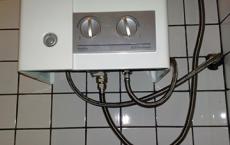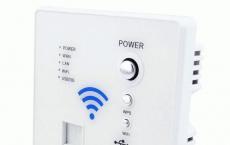What is fresh air ventilation. Features of the system. What to look for
Comments:
- Why is it necessary to supply exhaust ventilation?
- What should I look for?
- Ventilation system in living areas
- List of exhaust ventilation systems
- Important Settings
To date, there are many ventilation exhaust systems, performing one important function - they provide air exchange in the premises. The circulation of air can be carried out in various ways - this determines the type of exhaust ventilation that needs to be selected. Supply ventilation system - equipment that provides airflow to the room and allows it to be heated in the winter and cooled in the summer.
Why is it necessary to supply exhaust ventilation?
The main reason for installing exhaust ventilation is the disturbed air circulation in the room, especially if technological processes are carried out in it. But not only in production halls should there be a normal air exchange. Offices, houses, apartments should be saturated with fresh air for comfortable living and health of people. In addition, the exhaust ventilation allows you to clean the air of such negative substances as:
- cigarette smoke;
- dust;
- heavy metal vapor;
- various harmful substances, viruses, bacteria.
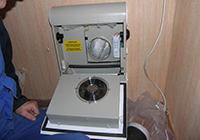
With the help of ventilation you can install:
- adjustment of the humidity level in the room;
- control over the temperature of the air indoors.
Ventilation of premises by opening windows and doors has long been irrelevant, because there is a ventilation system. Do not affect the equipment wind, precipitation and high air temperature in the summer.
In those places where there is a large number of people, there is a lack of oxygen and fresh air, which causes a completely unpleasant feeling of discomfort. In addition, modern norms and rules of the construction process state that the renovation of air in any premises should occur every 60 minutes. Thanks to new developments in the exhaust ventilation system, this condition is not violated and is observed according to all rules and norms.
Back to contents
What should I look for?
The main function that the exhaust ventilation performs is the supply of air to the room. And the air exchange should be evenly distributed throughout the perimeter. In addition, the air is cooled or heated, as well as filtered and humidified.
When it comes to the question of what type of exhaust ventilation system to choose, it is worth paying attention not only to the cost, but also to:
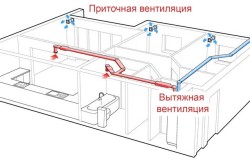
- presence of soundproof layers;
- availability and number of fans;
- number of filters;
- present air-heater regulators;
- hood.
An important factor is to draw up the correct calculation of the exhaust systems. This will ensure the subsequent qualitative installation of air exchange systems, which is due to air diffusers and diffusers. The exhaust system can have noise-absorbing elements.
The exhaust ventilation is equipped with automatic control. This allows you to maintain the desired temperature, adjust humidity and filtration, and also make the air warm or cold. The recovery of thermal air exchange makes the system highly economical and optimally efficient. The guarantee of ensuring "healthy" air in the room and the outflow of recycled air - all this provides ventilation.
Back to contents
Ventilation system in living areas
People suffer constant stress and chronic fatigue in most cases because of the polluted environment, especially in large cities. Chemical emissions of plants negatively affect human health. As you know, the house is a resting place. To make it really a fortress, not a congestion of harmful substances in the air, it is necessary to install an exhaust ventilation system.
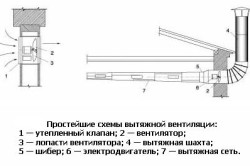
It will help to decontaminate the air and make life as comfortable and healthy as possible. The periodic airing carried out by people can be called a drop in the sea in comparison with how much fresh air a person needs hourly (at least 35 m3).
Ventilation of windows (natural ventilation) still does not guarantee the cleanliness of the environment. In addition, in a strong wind or hot heat air the living room is completely pointless. Exhaust ventilation does not depend on weather conditions and only after its installation, a person can not worry about the cleanliness of the environment.
The simplest ventilation system works according to the following principle:
- air exchange takes place through a through channel in the wall;
- the channel is equipped with heat and sound insulation;
- cover - decorative grilles.
But such a system will not provide air filtration and will not allow regulating its moisture content. Clean air in the apartment will be only if you install a modern exhaust ventilation system. Only in this case the ventilation of the air will be stable. Such systems are extremely convenient to use, but it is better to install them not independently, but with the help of specialists.
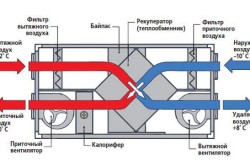
The exhaust system works silently, utilizing recycled air and saving electricity. Due to the permeability of the material from which the recuperator is made, water vapor passes into the apartment freely, and ammonia or carbon dioxide is retained. Ventilation makes the environment cleaner by 95% than on the street.
Depending on the manufacturers of ventilation systems, the equipment may be different. Equipment with more efficient filters will have a higher cost. There may be several filters or one.
Back to contents
List of exhaust ventilation systems
- Window valves. Installed on the upper window frames.
- Fans. Mounted in window frames or in the outer wall.
- Supply air exhaust ventilation systems are compact systems assembled into soundproofed monoblocks. They are considered universal and perform multiple functions.
Back to contents
Important Settings
![]()
When choosing an installation, you should pay attention to such parameters:
- what performance and statistical pressure ventilation has;
- what is the acoustic power of the unit;
- that is included in the complete set of ventilation system;
- what functions the automatic control system performs;
- what filters are installed to clean air flow.
Performance and statistical pressure parameters are needed to determine which model of ventilation equipment should be selected for a residential or technical room. Models of equipment with a capacity of 210-510 m³ / h are suitable for residential premises, the area of which is not more than 140 m³. Accordingly, ventilation systems with a performance rating are higher for technical rooms.
One of the important parameters is the acoustic power of the exhaust ventilation. The noise is measured at the inlet and outlet of the air. This parameter is especially important in apartments and houses. In modern systems, ventilation is quiet.
Pay attention when buying exhaust ventilation for the complete set:
- built-in automatic system;
- control panel with a display screen, in which the temperature, mode of operation will be displayed in the future.
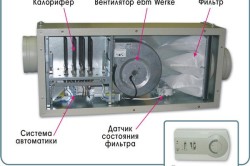
Automation is necessary to adjust the fan speed and the air temperature at the output. Modern equipment of ventilation systems has:
- function that allows you to monitor the level of contamination of filters;
- timers that automatically change the mode of operation;
- remote work timer;
- function "recovery", which allows you to restore operation in the event of a power failure or power outage.
Supply ventilation performs air purification. At the entrance to the monoblocks of the ventilation system, filters are installed that conduct rough cleaning, that is, purify the air of large dust, poplar fluff, animal wool. Installed additional filters delay atmospheric dust. Not all installations have additional filters.
A motley family of climate equipment is constantly replenished with a variety of new-fangled things.
But even the most heaped up humidifiers, ionizers and other tricks will not be able to provide acceptable conditions in the room if there is no high-quality ventilation.
In view of the wide distribution of metal-plastic windows, this issue has become particularly important. Let's see how the system of supply and exhaust ventilation should be in the apartment, so that those in the room feel really comfortable.
The lack of proper ventilation is not difficult to notice: the humidity is oversized, the room becomes stuffy, the working capacity of people is deteriorating and the state of health worsens. Therefore, in any room without exception, first of all, it is necessary to ensure sufficient air exchange.
In the traditions of domestic housing construction, this issue was decided to be solved in the least expensive way - due to the device of natural ventilation. Inside the walls, vertical ventilation ducts formed, the lower part of which emerged into the kitchen and the bathroom.
In the channel, as in the chimney, due to the temperature difference, natural draft appeared, while fresh air from the outside was pulled through the leaks in the windows. The effectiveness of such a system is highly dependent on weather factors, but with wooden windows it still somehow still worked. Now in apartments, where the usual windows were replaced with double-glazed windows in plastic frames, the benefits of it became very small. An attempt to revive ventilation by installing in the fan channel does not provide a full result, because the inflow is still limited.

The principle of the supply and exhaust ventilation
How to give fresh air to a corked apartment? Of course, you can install a special valve in the window frame or hole in the wall. But with our frosts, this solution is hardly an ideal one. Yes, and from the dust of the street I would like my home to somehow protect. Thus, it becomes evident that the supply ventilation must at least contain the basic components:
- heater;
- filter;
- fan (draw air through the filter at the expense of only natural draft will not work, and it works, as already mentioned, not in all weathers);
- control system and automation.
And now in what form are produced today such systems:
In large cities and industrial areas, air is often polluted and if you want to arrange forced ventilation in the apartment, you should think about air purification. : equipment selection and calculation example.
What kind of air heater to choose for forced ventilation, we will consider.
The installation of additional insulation and noise insulation in the apartment leads to one unpleasant effect - stagnation of air and the violation of ventilation. To return fresh air to the house will help to supply exhaust ventilation. Here we will look at the types of installations and their cost.
Demountable / type-making (modular)
It is assembled from separate elements, each of which is selected from a certain standard size series. This is the most flexible option: you can compose a system that ideally meets the specific situation.
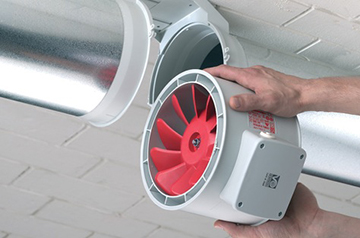 True, the average person this task will not be able to do it - it requires the competent performance of the following works:
True, the average person this task will not be able to do it - it requires the competent performance of the following works:
- Development of a project involving complex calculations.
- Build the system (requires knowledge of certain subtleties).
- A complex of start-up and adjustment activities (figuratively speaking, the system needs to be set up).
Thus, in addition to the purchase of parts and equipment will have to pay for the services of specialists.
Another drawback - systems of this kind require a lot of space. Usually they are used in industrial facilities, where a so-called ventilation chamber is used for them.
Monobloc
This design assembly and configuration takes place at the production stage, the user only needs to install it correctly. The housing, in which all the nodes are housed, is equipped with soundproofing. At the same time, the whole complex of equipment turns out to be very compact, which makes it suitable for use in private houses and apartments.
System of forced ventilation with heat recovery
This is the most economical version of the ventilation system. If, in the normal design, the "exhausted" air is removed from the living space through the ventilation risers in the kitchen and bathroom, then in systems with recuperation it is sent via a special channel to the heat exchanger, where its heat is used to heat the incoming flow from outside. The presence of a heat exchanger and an additional air duct makes this system more expensive.
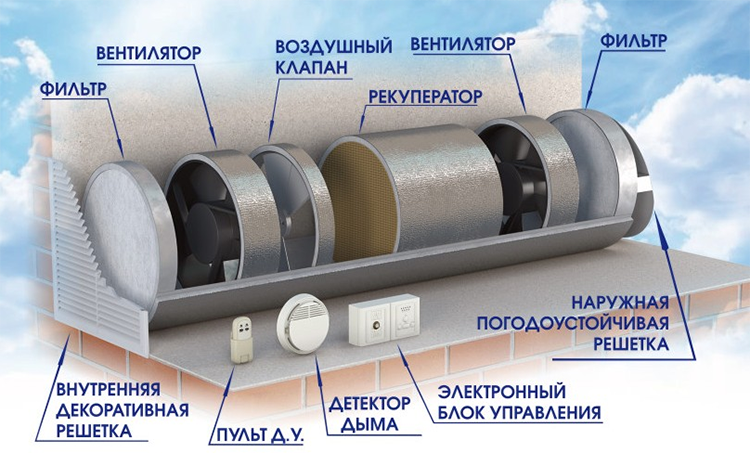
The scheme of supply and exhaust ventilation with heat recovery
She also has one more drawback: if a normal system in the kitchen and bathroom creates a back-up that prevents the spread of unpleasant odors, then if there is a recovery from this advantage will have to be abandoned.
Design features of ventilation
Depending on the design of monoblock ventilation systems are divided into several varieties.
Individual
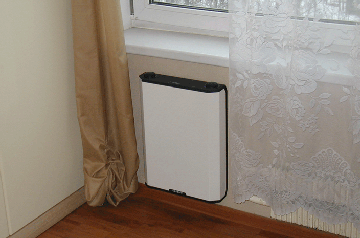 Small aggregates with a capacity of up to 100 cubic meters. m / h, designed to ventilate one room.
Small aggregates with a capacity of up to 100 cubic meters. m / h, designed to ventilate one room.
Since air ducts are not needed for such a device, installation is carried out quickly and with minimal damage to the decoration and interior.
Nevertheless, the individual systems did not receive special propagation, because they have two significant drawbacks:
- weak noise insulation;
- the possibility of installation only indoors.
The most famous manufacturers are the companies Thion, VentMachine and Mitsubishi Electric. The latter, among other things, produces a model Lossnayy with a recuperative heat exchanger, but it can function with an outside temperature of at least -10 degrees - with a stronger frost, frost is observed.
As an alternative to the individual "influx" you can consider air conditioners with a sub mix of outside air.
Ducting
More productive plants designed to supply fresh air through a network of air ducts to all rooms of the apartment or house. Air ducts are usually masked by suspended ceilings, so it is better to install such a system before finishing the premises.
With electric and water heating
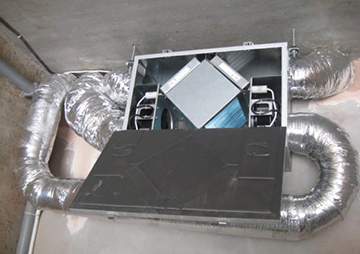 In low-power apartment units, the forced air is heated by electricity.
In low-power apartment units, the forced air is heated by electricity.
At the same time, the power consumption can be quite impressive - in a period of severe cold weather, a system with a capacity of 500 cubic meters. m / h for heating the air to a temperature of +18 degrees, as required by the SNiP, 5 kW will be required.
It is obvious that in installations with higher productivity used in cottages, electric heating will cost too much.
And the ability to connect powerful electrical equipment is not always available - the capacity of the cable or even a transformer in the substation is not enough. Therefore, in private houses, mainly supply air systems with a water heater are mounted, which is connected to a heating system.
Features of ventilation equipment
So, let's see how different models of air-supply systems differ.
Performance
To determine the performance, you need to make a competent calculation of the ventilation system.In the case of an apartment, you can use the averaged data:
- for apartments ranging from 30 to 60 square meters. m (1 - 2 rooms) require a capacity of 200 - 350 cubic meters. m / h;
- with an area from 70 to 130 square meters. m (3 - 4 rooms) - from 350 to 500 cubic meters. m / h.
In office premises or cottages install systems with a capacity of 2 - 3 thousand cubic meters. m / h, here you can not do without calculation.
Note that with a significant scale of the duct network, the performance of the installation will be less than the passport one. To determine its real value, it is necessary to find in the technical documentation a so-called ventilation characteristic - a graph showing the dependence of performance on the resistance of air ducts.
Static pressure
In other words, this is the pressure created by the fan. The magnitude of the required static pressure depends on the length of the ducts and the number of turns, the number of filters and their type. For small systems installed in two or three bedroom apartments, if there is a quality fine filter, the pressure will need 400 - 500 Pa.
If the calculation of performance and static pressure causes difficulties, you should purchase a model with a wide range of settings, for example, Breezart 550: LUX.
Its productivity can vary from 350 to 500 cubic meters per hour.
Noise level
Since the air handling unit operates in a constant mode, the level of noise produced by it is very important. To choose the quietest unit, you need to know some subtleties. The same noise level can be expressed in different units:
- LwA: acoustic power or noise level;
- LpA: Sound pressure level.
At the same level, the second value will be lower, so when comparing the two models, pay attention to the units of measurement.
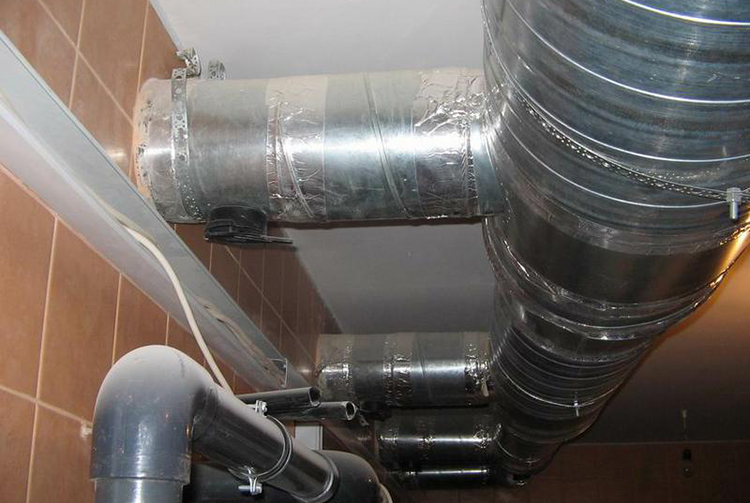
Ventilation ducts
It is also important not to confuse the noise levels measured at different points. In general, there are three of them: noise is measured at the air intake, near the unit itself and at the ventilation grille (at the outlet of the air duct).
If a silencer is to be installed at the outlet, its length must be at least 900 mm. Devices with a shorter length are ineffective.
Generally speaking, the data on the noise of the installation are very relative, since they depend on the distance between the equipment and the microphone - there are no uniform standards for this. So, if possible, try to arrange an "audition".
Monitoring the status of filters
The simplest settings signal the need to replace the filters with a certain periodicity, "clogged" in memory. It is clear that this method of control is purely conditional, since it does not track the actual state of the filter. More practical are installations in which special sensors evaluate the pressure drop on the sections before and after the filter. Based on the results, it is possible to accurately determine the degree of air cleaner debris.
![]() The installation of supply and exhaust ventilation can be arranged by yourself or trusted by specialists. Consider which option is the most optimal. : implementation plan and cost of work.
The installation of supply and exhaust ventilation can be arranged by yourself or trusted by specialists. Consider which option is the most optimal. : implementation plan and cost of work.
What is included in the service of supply and exhaust ventilation and how much it costs, read the material.
Video on the topic
Designed air supply ventilation system for submission to the premises of the person who passed the preliminary training (cleaning, humidifying or cooling, heating) of air. It is located either in one housing (monoblock supply unit), or is assembled from separate elements (coolers, air distributors, fans, valves, filters, air ducts and air heaters). Supply air ventilation system is a ready-made unit for supply ventilation.
Choose the manufacturer:
|
Supply air installations Ostberg |
Air-handling units Thion |
Compact air intake systemsoften used in cases where the level and amount of pollutants released into the air reach the limit of the maximum permissible concentration, and also require constant air replacement, regardless of the meteorological conditions. The supply ventilation is also used in the premises of a clean zone, if necessary, to protect them from cold air from the street or the penetration of contaminated air.
Types of air supply systems
- Natural: allows you to supply the room with fresh air, but it is less effective in cold seasons, as it pushes the inside of the room with frosty air, it chills the room temperature. In the room air comes from the temperature drops in the street and in the room itself.
- Forced: Used in cottages and large houses. Data combined extract and input systems turn on and off automatically as needed to save energy in cases where natural ventilation is sufficient.
Types of air supply systems
There are two types of supply air heaters: electric duct heaters (electric air-handling units) and water channel heaters (duct-type air-conditioning unit with water heater). Electric channel heaters can be installed in any position (except for the position of the electrical panel at the bottom). For the safe, correct operation of the heater it is necessary to use an automation system that provides protection and integrated control.
Water channel heaters can be installed behind or in front of the fan. The heater is connected according to the countercurrent principle. In order for the supply units with the water heater to function correctly, it is also necessary to use an automation system that, in the case of using water heaters, is somewhat more complicated.
At present, there are many types of air-supply plants, but among the most popular are, first of all, air-handling unitswith heat recuperation and a mini-supply unit. The supply unit with recuperation is designed for large rooms. It is capable of storing up to 50% of heat or cold. This function allows the installation of coolers / heaters of lower power, which in turn provides savings in gas or electricity.
Industrial supply plants are often installed in ventilation chambers or on roofs of buildings. A supply unit with cooling is installed in rooms for cooling products or materials. These can be shops, refrigeration rooms, in which it is necessary to maintain a low temperature. During the summer period, household air-supply plants are also used in crowded places.
Unlike the supply and exhaust system, the air handling unit with recuperator works exclusively for air intake from the outside. This device can be both with a water heater and with cooling.
To date, in the market of air-conditioning plants, you can find such options for ready-made systems, such as a pre-heating installation, supply gas installations, software-configured inflows. Therefore, to choose the ideal option is not difficult.
If you are interested in a fresh air installation, the cost of which differs by availability, you should familiarize yourself with the catalog presented on the pages of our website. With us you can buy fresh air ventilation, air-conditioning with forced ventilation quickly and economically. Also you can compare prices for air-handling units. Moscow, of course, offers the widest range, which is presented in our online store.
air-handling units air intake systems
If it is needed, air intake systems
Different types of systems
Modern air-handling units
air intake systems
air intake systems
Supply air ventilation systems
Modern technologies of ventilation equipment allow creating high-tech systems capable of providing high-quality and safe gas exchange within the premises or the whole building. Not the last place in the decision of numerous problems of ventilation occupy air intake systems, which become the basis of all ventilation communications. A variety of air intake systems allow you to select the optimal solution for all types of buildings.
Design features of air-conditioning units
Speaking about the supply and exhaust ventilation in the equipment, as a rule, they mean the systems of devices, equipment and devices intended for the replacement of air in the premises. The structures of such systems consist of two channels, one of which removes the exhaust air, and the other serves fresh. Each channel consists of separate devices that are connected to each other by air ducts. Forced ventilation systems usually include elements such as:
- Fans, guiding the movement of air through the ducts;
- Air intake grilles designed to protect the air ducts from ingress of foreign objects into them;
- Air filters that provide cleaning of outdoor air from impurities and small debris;
- Air valves that regulate the flow rate of incoming air and prevent the entry of cold air into the system when the system is switched off;
- Air ducts that connect all the elements into one air distribution system;
- Air distributors, which serve to distribute fresh air in the premises;
- Automatic control systems for the operation of the elements of the ventilation system, controlling its basic parameters;
- Sound attenuators, which reduce the noise level from the operation of fans in the system.
If it is needed, air-handling units can contain additional elements, such as heaters and air coolers, humidifiers and air dryers, throttle valves, recuperators, etc. Such devices allow not only supply of fresh air into the room, but also allows to regulate its main parameters - humidity, temperature, etc.
Different types of systems
Modern air supply systems and differ in their design - they can be monoblock or prefabricated type. The first type involves the installation of the main components and elements in a single package: fans, filters, air heaters, recuperator, automatic control system operation. The second is a separate device, joined together ducts ducts.
Design work in the creation of systems of supply and exhaust ventilation systems, as a rule, begins with the preparation of the building plan, which indicates the area and purpose of each room separately. Based on this plan, the design of the ventilation scheme of the premises is being developed, which provides all the required elements and locations.
Starting to calculate the parameters of the system you need to determine its main indicators. All air intake systems should perform certain functions, at the design stage should identify all the features of the structure of future communications. They include:
- the air pressure in the system, which fans must create during operation;
- permissible noise level during system operation;
- the cross-sectional area of ducts and the speed of airflow in them;
- power of air heaters for incoming air from outside;
- the value of the performance of the ventilation system, which is capable of providing the necessary air exchange in various places of the building.
The norms of supply and exhaust ventilation, which operate today, provide for the necessary air exchange parameters, which depend on the area of premises and the number of people in them. So, for residential premises the rate is about 2 -3 m 3 per hour per square meter or about 20 - 30 m 3 per adult. For household premises where a high content of harmful impurities in the air, high humidity or unpleasant odors (kitchen, bathroom, etc.) is possible, the norm increases by 2-3 times. Select and design air intake systems it is necessary with the help of professionals, since after installation of the equipment it will be difficult to correct the work of individual elements of the system.

